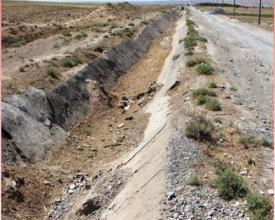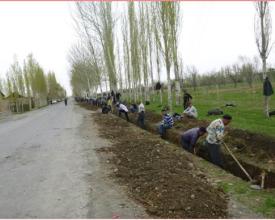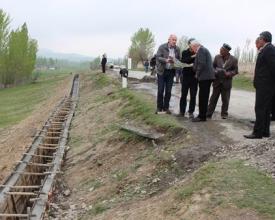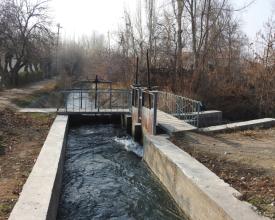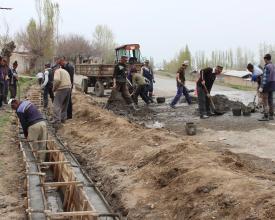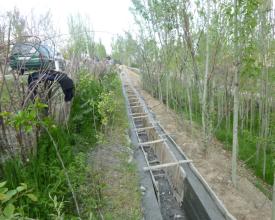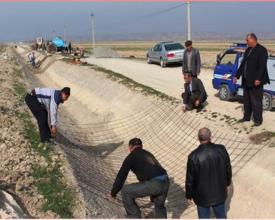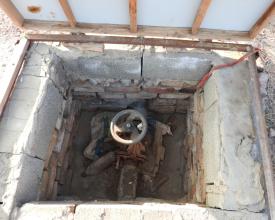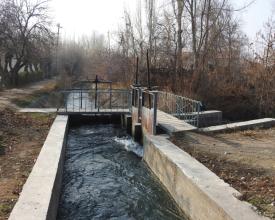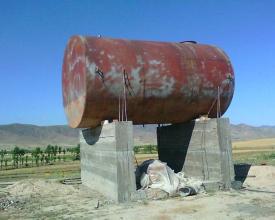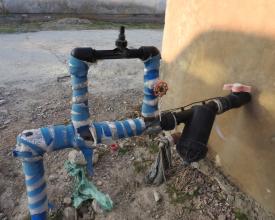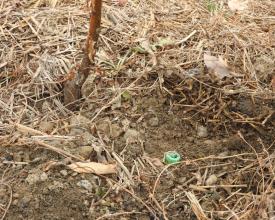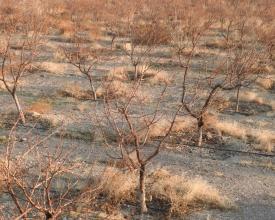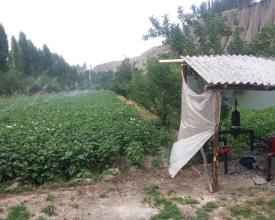
Amélioration de l'efficacité de l'utilisation de l'eau d'irrigation pour faire face à la pénurie d'eau liée au changement climatique
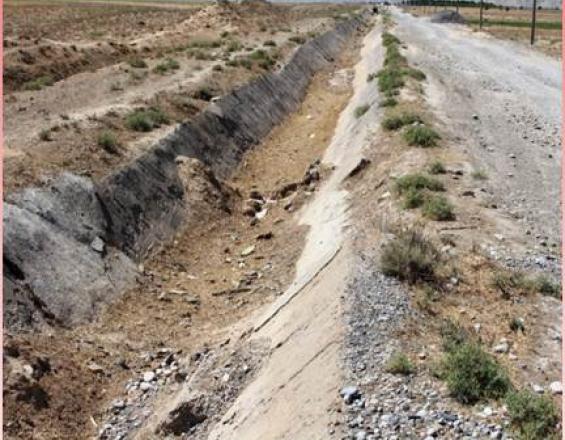
L'agriculture irriguée est souvent limitée par la disponibilité de l'eau d'irrigation. Dans de nombreuses zones irriguées, les canaux de distribution et les systèmes d'irrigation des exploitations sont en mauvais état, ce qui entraîne des pertes d'eau considérables. Ces problèmes sont de plus en plus exacerbés par l'impact du changement climatique qui entraîne une réduction de l'eau d'irrigation disponible avec des températures plus élevées et l'expansion de l'agriculture irriguée qui entraîne une augmentation de la demande en eau d'irrigation. L'augmentation de la fréquence et de l'intensité des crues soudaines et des laves torrentielles met en péril le fonctionnement des canaux d'irrigation et, partant, les moyens de subsistance des agriculteurs et la sécurité alimentaire.
La solution a permis de réduire les pertes substantielles d'eau d'irrigation causées par les infiltrations dans les canaux, les problèmes structurels des systèmes d'irrigation et l'irrigation à la ferme. Elle s'attaque également aux risques causés par les crues soudaines et les laves torrentielles. La solution repose sur un soutien technique et financier aux communautés locales en collaboration avec les autorités de gestion de l'eau du district.
Contexte
Défis à relever
Les communautés, les agriculteurs et l'administration du district ne disposaient pas des moyens financiers et des capacités techniques nécessaires pour améliorer les éléments des systèmes d'irrigation et les adapter à l'impact du changement climatique. Pour les agriculteurs, les coûts d'investissement d'une irrigation efficace à la ferme étaient prohibitifs pour tester ces technologies. Avec l'aide du projet, ces défis ont été relevés, l'investissement externe et l'apport technique ont été combinés avec des contributions substantielles des communautés et des utilisateurs des terres.
Emplacement
Traiter
Résumé du processus
Les trois modules concernent les éléments clés de l'utilisation de l'eau d'irrigation : la source d'eau, les systèmes d'acheminement et de distribution et l'utilisation de l'eau dans l'exploitation pour la production agricole. Ces trois éléments contribuent à lutter contre l'impact du changement climatique en permettant une utilisation plus efficace de l'eau d'irrigation. L'ensemble du système d'agriculture irriguée devient ainsi moins sujet à l'impact du manque d'eau d'irrigation et de la sécheresse qui devrait devenir plus fréquente en raison de la diminution et de l'irrégularité des précipitations, de la réduction du stockage des précipitations dans les champs de neige et les glaciers et de l'augmentation des températures estivales. En outre, en particulier grâce à l'amélioration des canaux, le risque croissant de catastrophe est pris en compte, ce qui rend l'ensemble du système d'irrigation plus résilient.
Dans la pratique, certains des modules peuvent être mis en œuvre indépendamment, lorsque seuls certains éléments du système d'irrigation nécessitent des changements ou des améliorations.
Blocs de construction
Réhabilitation (revêtement) des canaux pour réduire les pertes par infiltration
De nombreux canaux d'irrigation sont soit uniquement en terre, soit le revêtement en béton est cassé. Les canaux qui fuient perdent des quantités substantielles d'eau, qui n'est donc pas disponible pour l'irrigation. De plus, en cas d'inondations et de coulées de débris, ces canaux peuvent facilement se rompre et causer des dégâts considérables.
Les communautés et les utilisateurs des terres, en collaboration avec les autorités de gestion de l'eau du district, ont choisi les sections nécessitant un renforcement et un revêtement. Les travaux ont été réalisés avec le soutien technique et financier de la GIZ, qui a fourni les ingénieurs chargés des mesures de réhabilitation et a financé l'achat et le transport des matériaux. Les communautés et les utilisateurs des terres ont réalisé les travaux par le biais du "hashar", le travail bénévole commun.
Les canaux d'irrigation réhabilités assurent un approvisionnement sûr et stable en eau d'irrigation, évitant ainsi l'engorgement et l'inondation des terres situées le long des canaux. L'entretien ultérieur est assuré par les communautés locales par l'intermédiaire de leurs mahalla (comités villageois) et jamoats (structure communale d'autogestion au niveau du sous-district).
Facteurs favorables
La combinaison de connaissances techniques solides et de matériaux appropriés - financés par le donateur - avec la volonté des membres de la communauté et des utilisateurs des terres de donner de leur temps sous forme de travail bénévole a rendu la solution possible.
Leçon apprise
La clé du succès réside dans la combinaison de bonnes compétences techniques et de matériaux adéquats avec la contribution de la population locale. Une réhabilitation entièrement financée et mise en œuvre par l'extérieur n'aurait pas permis d'assurer l'appropriation et l'entretien futur. Elle aurait donc probablement été moins durable. D'autre part, sans les compétences techniques externes et la fourniture de matériaux appropriés, les communautés et les utilisateurs des terres n'auraient pas été en mesure d'exécuter les travaux dans de bonnes conditions.
Diversité des sources d'eau
L'eau d'irrigation peut provenir de différentes sources. Dans la région où la solution est mise en œuvre, ces sources sont les suivantes :
- le fleuve Syrdarya, d'où l'eau est pompée à travers de grandes canalisations ;
- les canaux d'irrigation ;
- des puits ;
- les petites sources, qui sont captées par des moyens simples ;
- la collecte de l'eau de pluie sur les toits des maisons.
Les différentes sources d'eau sont liées à une diversité de systèmes de gouvernance. Le gouvernement régional possède et entretient les grandes canalisations et les canaux, les canaux d'irrigation de taille moyenne sont sous la responsabilité des autorités de gestion de l'eau du district et les structures plus petites sont entretenues par les communautés ou par les agriculteurs individuels.
En fonction des quantités d'eau d'irrigation disponibles et des coûts associés, des technologies de plus en plus nouvelles et économes en eau sont appliquées pour l'irrigation des terres.
Facteurs favorables
La diversité des sources d'eau d'irrigation est un facteur favorable en soi qui, associé à la disponibilité de diverses technologies, permet la poursuite de l'agriculture irriguée dans les conditions d'aridité croissante et de pénurie d'eau d'irrigation induites par le changement climatique.
Leçon apprise
L'agriculture irriguée peut être efficace et efficiente avec différentes sources d'eau d'irrigation. Des innovations créatives et l'application des meilleures pratiques permettent de capter même de petites sources d'eau d'irrigation et de les utiliser pour des cultures dépendantes de l'irrigation, ce qui permet de générer des revenus locaux. La résilience des utilisateurs des terres aux effets du changement climatique s'en trouve améliorée.
Technologie d'irrigation efficace
L'irrigation conventionnelle dans la zone concernée par la solution était uniquement une irrigation par sillons. Cette technologie nécessite de grandes quantités d'eau d'irrigation. En cas de pénurie d'eau d'irrigation, en particulier dans les situations de sécheresse, qui sont de plus en plus fréquentes en raison du changement climatique, l'irrigation par sillons n'est pas possible - l'eau ne peut tout simplement pas atteindre toutes les parties du champ et être absorbée par les plantes.
Dans le cas des pommes de terre, l'augmentation de la chaleur provoque un stress pour les plantes.
Des technologies d'irrigation plus efficaces et adaptées au changement climatique, telles que l'irrigation au goutte-à-goutte, ont été introduites. L'irrigation au goutte-à-goutte permet de fournir de l'eau d'irrigation à des plantes individuelles de manière ciblée. En outre, elle peut être utilisée pour appliquer des engrais dans des proportions correctes et de manière extrêmement efficace.
L'irrigation par aspersion convient parfaitement aux pommes de terre et peut contribuer à réduire le stress thermique lorsque l'eau disponible est suffisante et de bonne qualité.
Facteurs favorables
La volonté des agriculteurs d'essayer de nouvelles technologies d'irrigation a été largement motivée par la prise de conscience croissante des limites de l'irrigation conventionnelle par sillons, l'expérience des pénuries d'eau et la politique des gouvernements nationaux et régionaux visant à appliquer des technologies d'irrigation économes en eau, par exemple dans les terres nouvellement irriguées de la ville de Sayhun, qui dépendent entièrement de l'irrigation par pompage coûteuse avec l'eau de la rivière Syrdarya. Le besoin a été satisfait grâce à la disponibilité de connaissances en ingénierie et en agriculture et au financement fourni par la GIZ.
Leçon apprise
L'irrigation au goutte-à-goutte et l'irrigation par aspersion ont été testées avec succès pour diverses cultures, mais la viabilité économique de ces technologies d'irrigation efficaces varie. L'irrigation au goutte-à-goutte n'est économiquement viable que lorsque l'équipement d'irrigation limité permet de produire des rendements élevés pour des cultures qui se vendent cher, comme les fruits et les melons. Pour les cultures de masse, comme les oignons et les pommes de terre, l'investissement requis est trop élevé par rapport aux prix obtenus pour la récolte. Toutefois, si l'eau d'irrigation se raréfie, si le matériel d'irrigation devient plus abordable et/ou si les prix des produits agricoles augmentent, cette situation pourrait changer et l'irrigation au goutte-à-goutte pourrait devenir abordable pour ces cultures également.
Aujourd'hui déjà, l'irrigation par aspersion peut être efficace lorsque l'augmentation des températures compromet la productivité et la qualité de la culture de pommes de terre.
Impacts
Impacts sur l'environnement :
- Réduction de la consommation d'eau d'irrigation.
Impacts sociaux :
- Sensibilisation accrue à l'impact du changement climatique et à l'importance d'une utilisation efficace de l'eau d'irrigation ;
- Mobilisation des membres de la communauté, des ressources propres de la communauté et du financement des donateurs pour un travail commun visant à résoudre les problèmes affectant tous les agriculteurs/membres de la communauté ;
- Amélioration des connaissances techniques des communautés et des départements concernés sur la construction de systèmes d'irrigation minimisant les pertes d'eau et réduisant les risques de catastrophes ;
- La collaboration entre le donateur, le département de gestion de l'eau du district, les dirigeants de la communauté et les membres de la communauté a été consolidée ;
- La collaboration entre le donateur, le département de gestion de l'eau au niveau du district, les dirigeants de la communauté et les membres de la communauté a été consolidée ;
- Réduction des risques de catastrophe.
Impacts économiques :
- Réduction de la pénurie d'eau d'irrigation ;
Réduction du risque de défaillance des systèmes d'irrigation en raison de catastrophes ;
- L'amélioration de l'efficacité de l'irrigation permet d'obtenir "plus de récoltes par goutte" et donc de réduire les coûts de l'eau d'irrigation ;
- Des rendements sûrs dans l'agriculture irriguée, des revenus plus stables pour les agriculteurs et une meilleure sécurité alimentaire ;
- L'eau des canaux d'irrigation est également disponible pour les besoins des ménages.
Bénéficiaires
- Agriculteurs pratiquant l'agriculture irriguée ;
- Villageois utilisant l'eau d'irrigation pour les jardins potagers et pour les besoins domestiques
Objectifs de développement durable
Histoire
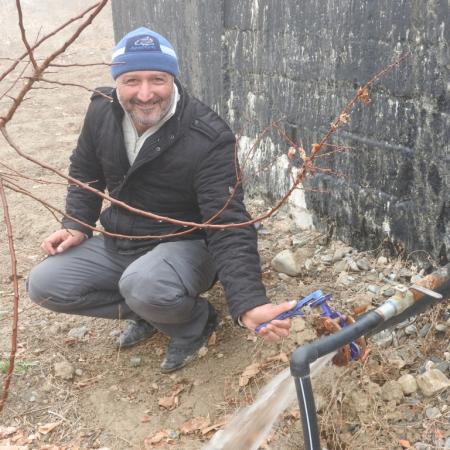
L'augmentation de la population a contraint le gouvernement du Tadjikistan à établir de nouveaux villages sur des terres où l'eau d'irrigation est très limitée. Sadulloh est l'un des habitants de ce nouveau village, situé près du centre du district de Shahriston. Avant la construction des maisons, les terres étaient utilisées pour l'agriculture pluviale et le pâturage du bétail. Le sol limoneux ne permet la culture d'arbres fruitiers et de vergers que lorsque l'eau d'irrigation est disponible. Mais l'eau provenant d'une source et acheminée par un pipeline suffit à peine comme eau potable. En période de sécheresse, les habitants achètent l'eau amenée dans les villages par un camion-citerne au prix de 75 somonis (environ 8 USD) pour 2 mètres cubes. Ainsi, même les jardins des maisons ne peuvent pas être irrigués.
La solution consisterait à capter autant que possible les précipitations. Les précipitations ne sont pas fiables et se produisent souvent sous forme d'averses rares, brèves et abondantes. Sadulloh et les ingénieurs du projet ont modifié les gouttières de sa maison pour récupérer l'eau du toit. Un réservoir en béton a été construit, assez grand pour recueillir suffisamment d'eau pendant la saison des pluies afin d'irriguer le jardin de sa maison.
Pour utiliser au mieux l'eau d'irrigation, Sadulloh a installé, avec l'aide des ingénieurs du projet, un système d'irrigation au goutte-à-goutte, qui alimente plus de deux douzaines d'arbres fruitiers - pommes, poires, pêches, abricots, mûres - ainsi que ses légumes. Il peut ainsi produire suffisamment pour sa famille élargie de huit personnes. Aujourd'hui, la technologie est copiée par ses voisins.
